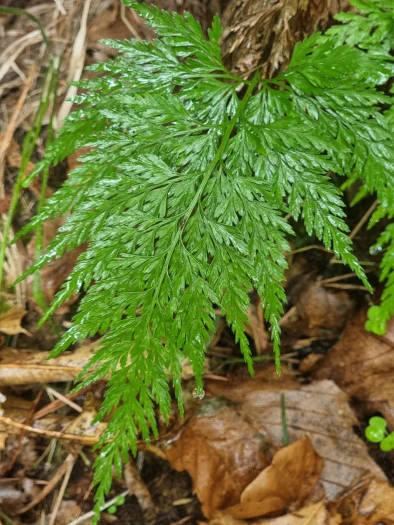Irish Spleenwort
(Asplenium onopteris)
Irish Spleenwort (Asplenium onopteris)
/
/

Vítor Jorge
CC BY 4.0
Image By:
Vítor Jorge
Recorded By:
Copyright:
CC BY 4.0
Copyright Notice:
Photo by: Vítor Jorge | License Type: CC BY 4.0 | License URL: http://creativecommons.org/licenses/by/4.0/ | Rights Holder: Vítor Jorge | Publisher: iNaturalist | Date Created: 2023-09-16T10:25:14-07:00 |























Estimated Native Range
Climate Requirements
| • Precipitation | 5" - 85" |
| • High Temp. | 57°F - 96°F |
| • Low Temp. | 14°F - 59°F |
Summary
Asplenium onopteris, commonly known as Irish spleenwort or western black spleenwort, is a perennial herbaceous fern native to rocky slopes and crevices within Mediterranean woodlands, scrublands, and coastal cliffs, as well as the Eastern Atlantic islands. It is diploid and serves as one of the progenitor species of the tetraploid A. adiantum-nigrum. First described by Linnaeus in 1753, it is a member of the "Onopteris subclade" within the "Pleurosorus clade." This fern typically forms dense tufts of triangular, pinnate fronds that are dark green in color, reaching up to 20 cm in length. The sori, or spore-producing structures, are found on the underside of the fronds and are covered by a membranous indusium.
Irish spleenwort is valued for its hardiness and ability to thrive in shaded, rocky environments, making it a suitable choice for rock gardens, green roofs, and as a ground cover in shaded areas. It requires well-drained soil, moderate moisture, and can tolerate a range of light conditions from part shade to full shade. While it is not prone to serious diseases or pests, it can suffer from root rot if overwatered or planted in poorly drained soils. In cultivation, it is appreciated for its low maintenance and textural contrast in fern collections or woodland gardens.CC BY-SA 4.0
Irish spleenwort is valued for its hardiness and ability to thrive in shaded, rocky environments, making it a suitable choice for rock gardens, green roofs, and as a ground cover in shaded areas. It requires well-drained soil, moderate moisture, and can tolerate a range of light conditions from part shade to full shade. While it is not prone to serious diseases or pests, it can suffer from root rot if overwatered or planted in poorly drained soils. In cultivation, it is appreciated for its low maintenance and textural contrast in fern collections or woodland gardens.CC BY-SA 4.0
Plant Description
- Plant Type: Fern
- Height: 1.5-2 feet
- Width: 1.5-2 feet
- Growth Rate: Moderate
- Flower Color: N/A
- Flowering Season: Non-Flowering
- Leaf Retention: Evergreen
Growth Requirements
- Sun: Part Shade, Full Shade
- Water: Medium
- Drainage: Medium
Common Uses
Low Maintenance, Potted Plant, Rock Garden
Natural Habitat
Native to rocky slopes and crevices within Mediterranean woodlands, scrublands, coastal cliffs, and the Eastern Atlantic islands
Other Names
Common Names: Irish Asplenium, Bird’s Nest Fern
Scientific Names: Asplenium onopteris, Asplenium acutum, Asplenium acutum, Asplenium adiantum-nigrum f. onopteris, Asplenium adiantum-nigrum subsp. acutum, Asplenium adiantum-nigrum subsp. onopteris, Asplenium adiantum-nigrum subsp. onopteris, Asplenium adiantum-nigrum subsp. onopteris, Asplenium adiantum-nigrum var. acutum
GBIF Accepted Name: Asplenium onopteris